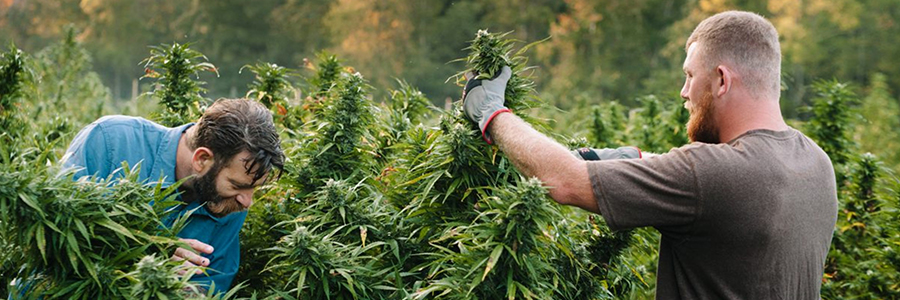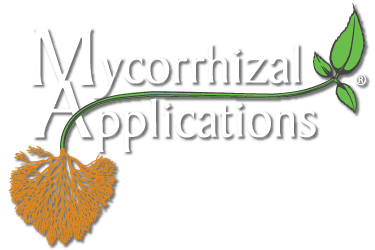
Can Hemp Benefit from Mycorrhizae?
Hemp is mycorrhizal, and in fact, hemp growers have been utilizing this technology for years to maximize crop performance and success. Hemp plants (and all plants in that genus) have a symbiotic relationship with endomycorrhizal fungi, also known as Arbuscular Mycorrhizal Fungi or AMF. The benefits that mycorrhizae provide to hemp are not unique, as this AMF relationship covers around 85% of plant species, however, there are many elements of hemp cultivation that make the use of mycorrhizae particularly beneficial.
Inoculation Timing
Similar to other plants, whenever possible, hemp plants should be treated during propagation or as early in the growth or production cycle as possible. We suggest that hemp growers apply MycoApply products containing Endomycorrhizae during propagation for three reasons: First, the cost of application is the lowest since you only apply the mycorrhizae to the seeded plug or clonal liner soil volume and not the final container. Second, the earlier you apply the mycorrhizae the sooner you start the symbiosis clock. The symbiosis between the plant and the mycorrhizae typically takes about four-weeks to establish. The sooner the plant is treated the sooner the plant can start to benefit. Visual benefits that the grower can see typically start to appear in an additional four weeks. And finally, the third reason is that when you transplant the liner/plug treated with mycorrhizae, the mycorrhizae treatment transfers with the liner/plug soil volume. And if that is not enough of a benefit, unlike most other production treatments, you do not need to reapply throughout the production cycle. One application is all you need. Mycorrhizae can be applied during propagation either through soil incorporation of your growing media before you plant or via a drench of the plug or liner before or after planting.
Hemp + Mycorrhizae ROI
One thing that is unique about hemp compared with bedding plant production is the cost of genetics. Feminized seed or vegetative clones have a cost structure more similar to non-generic nursery stock. The cost of potential loss can be substantial. The desire to reduce plant loss leads us to one of the most important benefits of mycorrhizae use: the reduction of transplant loss and transplant shock. It is important to remember that this benefit can only happen if the mycorrhizae are applied during propagation and the symbiosis between the plant and the mycorrhizae is able to develop before the plant is transplanted. Transplant loss is a simple term to understand. The goal of all growers is to reduce and ultimately eliminate all plant loss during transplant. Transplant shock on the other hand is a catch-all term referring to the number of stresses associated when a plant is transplanted from one soil environment to another soil environment. The level of transplant shock is usually defined by the length of time it takes the plant to resume growing at a rate similar to or greater than it was growing before it was transplanted. Transplant shock can also ultimately lead to transplant loss.
The reduction of transplant shock gives the grower a more uniform hemp crop in the field that can more fully take advantage of the vegetative growth period before the flowering stage is initiated.
How do Mycorrhizae Benefit Hemp Plants?
It is important to understand that the primary feature of the mycorrhizal symbiosis for hemp is they work to expand the root absorptive area of the hemp plants. The increased root absorptive area of mycorrhizae-treated hemp plants allows the hemp plant to take up water more efficiently and absorb nutrients more effectively. Additionally, a greater amount of the applied nutrients is made available for use by the hemp plant, so less fertilizer will leach through the rhizosphere beyond the reach of the plant. Mycorrhizae are also capable of unlocking non-soluble nutrients found within the soil and making them available to the plant. When nutrients are in excess they are stored by the mycorrhizae and made available for future use by the plant. Water is absorbed by the mycorrhizae hyphae and transported to the plant. When water is in excess, the hyphae become a repository for future water needs.
Mycorrhizae also have the ability to insulate the plant from salinity, both water and soil originating, and heavy metals. If mycorrhizae come across either of these situations, they absorb the salt or heavy metal and store it away so it can not cause harm to the plant. Endomycorrhizae (AMF) are obligate symbiotes, meaning the mycorrhizae need the plant for long-term survival. A hemp plant associated with mycorrhizae will experience less stress, leading to improved plant health and ultimately a more successful hemp crop.
One additional variable that hemp production success is directly tied to is the quality of the field soil the plants are grown in. Fortunately, mycorrhizae can also positively influence soil structure. Soil structure can be defined as the arrangement of organic/mineral complexes (aggregates) and pore spaces. In 1996, scientists at the USDA, identified ‘glomalin’, a glycoprotein produced abundantly on hyphae of endomycorrhizal fungi. Glomalin acts as a ‘soil glue’ that binds micro-aggregates of soil into stable macro-aggregates. (You can think of glomalin in a similar way to the melted marshmallow holding together the Rice Krispies in a Rice Krispie treat.)
Recommended Products:
MycoApply® Endo
Granular, low-cost, easiest to incorporate into soils or growing media, OMRI-Listed.
MycoApply® Injector Endo Organic
Highest concentration of mycorrhizae, soluble humic carrier, maximum application efficiency through horticulture injection systems, OMRI-Listed.
MycoApply® Ultrafine Endo
Suspendable powder, can be applied via drench or soil incorporation, OMRI-Listed, sold in 1 lb., 20 lb., or Bulk packaging.
MycoApply® Soluble MAXX
Maximum diversity in mycorrhizal species, contains kelp and humic acids, suspendable powder, OMRI-Listed, sold in 1 lb. bags.

